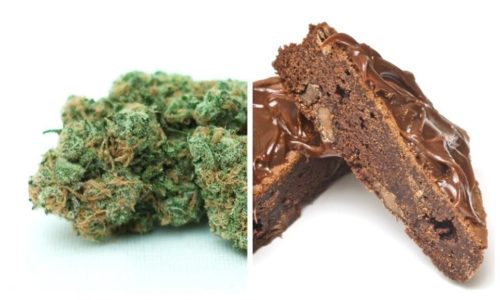1. THC is Absorbed Differently
Why are cannabis-infused edibles typically so much stronger than smoked or vaporized cannabis? When you consume cannabis in an ingestible form, its THC is metabolized by the liver, which converts it to 11-hydroxy-THC. This active metabolite is particularly effective in crossing the blood-brain barrier, resulting in a more intense high. Inhaled THC undergoes a different metabolic process because rather than passing through the stomach and then the liver, the THC travels directly to the brain. This is why the effects of smoked or vaporized cannabis come on faster and diminish quickly.
2. Effects and Duration
The Golden Rule of edibles: start small and be patient. Because of the way edibles are metabolized, it can take anywhere from 30 minutes to 2 hours to kick in, and the effects can last several hours. These effects vary between edibles, but generally, consumers report stronger body effects coupled with an almost psychedelic head high in large doses. Smaller amounts yield milder and arguably more comfortable effects, which is why we reiterate: start small and be patient, or you’re gonna have a bad time.
Edibles may be strong, but compared to inhaled cannabis, they actually deliver a smaller concentration of cannabinoids to the bloodstream. Ingesting edibles introduces only 10 to 20 percent of THC and other cannabinoids to the blood plasma, whereas inhaled cannabis falls closer to 50 or 60 percent. The effects of smoked cannabis tend to peak within the first 10 minutes and rapidly dissipate over the next 30 to 60 minutes.
3. Edibles are More Difficult to Dose
Determining the THC content of a homemade batch of edibles is no easy feat, and even professional distributors sometimes have difficulty capturing the advertised dose in their products. Because of the delay between ingestion and onset of effects, consumers may sometimes overestimate the dose. Inhaled cannabis, with its instantaneous effects, allows the consumer to gradually dose as needed.
4. Disparities in Advertised Potency
As touched on previously, even packaged edibles found at dispensaries screw the pooch every once in a while with products that don’t exactly match the expected dose. Keep in mind that your go-to distributor may have a batch that varies from the last one you tried, so if you think, “The last time I tried this, it was fairly weak, so this time I’ll eat twice as much!”, you may find out the hard way that this latest batch is a lot stronger than what you expect. Legal cannabis systems are moving toward stricter regulations for edible testing and THC content, but if you’re living in a state without these guidelines in place, be sure to ease into your edible expedition slowly and cautiously until regulations and testing pave the way for consistency and accurate labeling.
5. Edibles as a Healthier Alternative to Smoking
Many people become interested in edibles because they don’t enjoy the harsh experience of smoking or are worried about the long-term health concerns associated with it. Vaporization is another health-conscious alternative commonly recommended, but edibles can often times provide longer effect, making them a preferred choice for medical patients.



